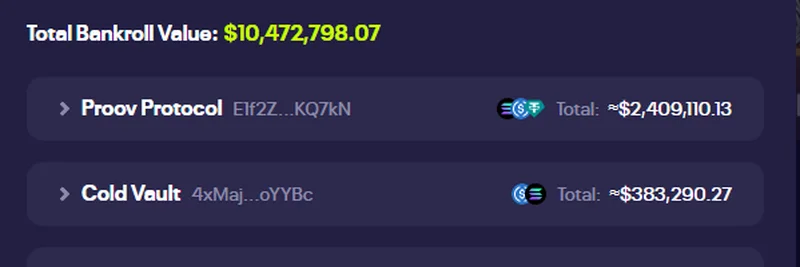In the wild world of crypto gambling, trust is everything. But how do you really know if a casino has the funds to pay out your wins? A recent tweet from @vydamo_ on X (formerly Twitter) puts it bluntly: if your casino lacks on-chain proof of funds, it's basically begging to rug you—like calling it "ourbit" because it'll take your money and run when things get tough. The tweet, which you can check out here, highlights a screenshot from Luck.io, a non-custodial casino on Solana, showing over $10 million in verified bankroll.
What is On-Chain Proof of Funds?
On-chain proof of funds is a blockchain feature where a casino publicly verifies its reserves directly on the ledger. Unlike traditional online casinos that might hide behind opaque systems, this setup lets anyone audit the funds in real-time. For Luck.io, this means their bankroll—split across a proof protocol, cold vault, and smart contract—is fully transparent, totaling around $10.47 million as per the tweet. It's built on Solana, a fast and low-cost blockchain popular for meme tokens and DeFi apps, ensuring instant settlements without needing an account or KYC.
This transparency isn't just a gimmick; it's a game-changer in an industry plagued by scams. Remember the FTX collapse? Centralized platforms can vanish overnight, but on-chain proof adds a layer of trustlessness—meaning you don't have to rely on the operator's word.
Why Luck.io Stands Out in the Crypto Casino Space
Luck.io positions itself as the first truly non-custodial casino on Solana, with provably fair slots and games. Wins are paid out instantly to your wallet, no middleman involved. The tweet sparked replies praising this approach, with users like @TheMisterFrog calling it "real" and others asking for referral links. It's a nod to how Luck.io differentiates from shady competitors by embracing full on-chain verification.
But it's not without controversy. Some reports, like this Reddit thread, question their influencer marketing spends—allegedly $500K monthly—raising eyebrows about sustainability. Still, their on-chain model aligns with the ethos of blockchain: verifiable and decentralized.
Tying It to Meme Tokens and Broader Blockchain Trends
Meme tokens thrive on Solana, where communities pump volatile assets like dog-themed coins or viral jokes. Crypto casinos like Luck.io fit right in, allowing bets with these tokens in a transparent environment. Imagine wagering your favorite meme coin on slots, knowing the house's funds are locked on-chain. This reduces rug pull risks, a common fear in meme ecosystems, and could boost adoption among blockchain practitioners looking for fun, fair ways to engage with their holdings.
As meme tokens evolve, tools like on-chain proof help build a more robust knowledge base for users. It's not just about gambling—it's about understanding how blockchain tech enhances security and fairness in everyday applications.
Final Thoughts
The tweet from @vydamo_ serves as a wake-up call: in crypto casinos, demand on-chain proof or risk getting "ourbit-ed." Platforms like Luck.io are leading the charge, offering a blueprint for transparency that could reshape the industry. If you're diving into Solana gambling or just curious about provably fair games, start by verifying the bankroll yourself—it's all on the chain.


